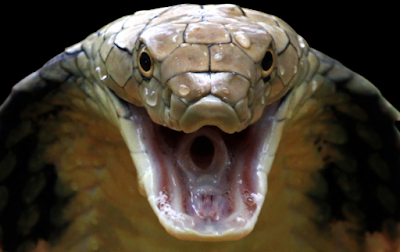Image credits to worldpress.com
Female King cobra builds a nest.
Female king cobra is only snake that builds a nest . It consists of leaves , weeds and other loose and rotting vegetation around the area . Once the eggs are all tucked in place , she covers them with more leaves , then rests on top of the pile .
Image credits to Grunge
King Cobra venom is dangerous.
Poisoning is dangerous, but King Cobra's venom is very dangerous. The amount of neurotoxins it can deliver in a single bite is enough to kill 20 people or an elephant, up to two-tenths of an ounce of liquid.
Image credits to wikipedia
King cobra is the longest of all venomous snakes
King cobra is the longest of all venomous snakes In averages 3-4 m in length , but the longest specimen on record had attained a length of 5.71 m .
King cobra venom effects
It affects the respiratory centers in the brain , causing respiratory arrest and cardiac failure .
Their 'Hoods' Are Actually Ribs
When a king cobra is on the defense, it produces a distinctive hood that flares around its face. This hood, as well as other parts of the snake's body, all have markings that are unique to the king cobra. At first glance, it looks like part of the snake's skin, but it's actually a system of rib bones and muscles that can flex and move. To make itself appear larger and more dangerous, the king cobra spreads these ribs and fans out the hood as it hisses and "stands" up.
They Have Long Lifespans
In the wild, these snakes can live for more than two decades. Since they can survive for long periods of time without eating and don't require much water.













No comments:
Post a Comment